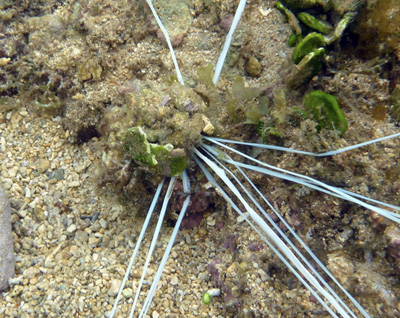Published in the Ocean Watch column, Honolulu Star-Advertiser © Susan Scott
February 18, 2013
Last week I braved the North Shore’s bone-chilling cold to go snorkeling. It was worth the chicken skin. I got to look down the throat of a spaghetti worm.
Having grown up in Wisconsin, I’m joking about Hawaii’s cold, but only partly. Thyroid hormones regulate body temperature, but after living on Oahu for 30 years, my heat glands have apparently retired. With Oahu’s water temperature at its winter low of 76 degrees and the morning air in the mid-60s, I had to force myself to plunge in.
A spaghetti worm’s feeding tentacles, which can
extend up to 3 feet, capture plankton particles.
©2013 Susan Scott
And there was the worm of my dreams.
I don’t really dream about worms, but I do admire them. I’m particularly fond of the kind that spend their entire lives inside self-made tube homes, such as spaghetti worms, even though I never actually see them. If the creatures didn’t stick their tongues out to eat, I wouldn’t even know they were there.
A spaghetti worm makes its cylindrical home under a rock or inside a reef crevice by gluing together sand and bits of gravel with a mucuslike secretion from a gland near its head. Also around the head are corkscrew tangles of red gill filaments, the creature’s breathing organ.
An adult spaghetti worm’s body is 5 to 6 inches long and about an inch thick, but you won’t see it because it stays hidden all its life.
The parts of the worm we do see are its multiple fettuccinelike feeding tentacles that extend from the head. Each “noodle” is about a quarter-inch wide and can extend up to 3 feet. When plankton particles drop out of the current onto the tentacles, tiny beating hairs move it along a groove, like a rain gutter, into the mouth.
The worm can also use its elastic tentacles to lasso larger food items and drag them to its mouth.
When danger approaches, such as one of the worm’s major predators, a blue-stripe butterfly fish or a cone snail, it can withdraw its tentacles completely into its head. The worm is slow in its retreat, but if a noodle gets nipped it’s no big deal. The worm can regrow its tonguelike tentacles.
Spaghetti worms usually build their tubes so deep that I rarely see the origin of the white pasta that looks spilled on the reef. But during my brutally cold snorkeling venture, I found a spaghetti worm with its head above the surface of the ocean floor (above).
The worm wore a sand and seaweed hat cemented over its head, but I got a brief glimpse of its mouth hole before it hauled in its feeding tentacles.
Now I know where it lives. Before I revisit, though, I’m buying a neoprene vest.
